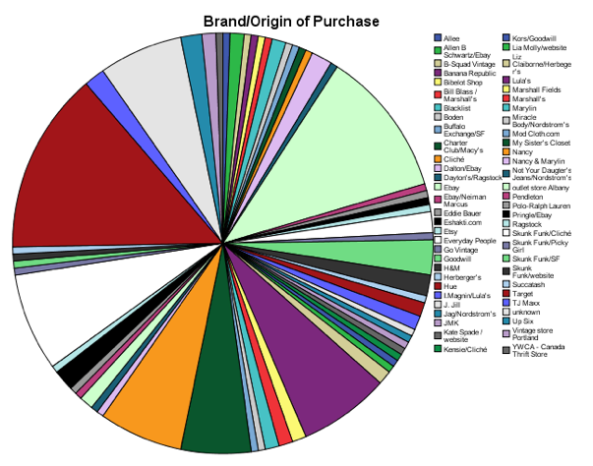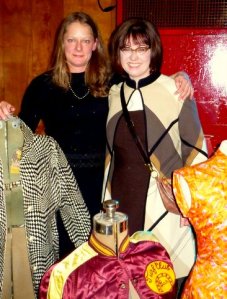Maybe it’s the New Year’s Eve champagne talking, but I must admit that I feel somewhat hopeful about the direction discussions about fashion and clothing production have taken this past year. For New Year’s, a list seems appropriate. Here are some stories from 2013 that have given me reason to hope that the fashion industry and our own patterns of consumption are changing as we head into 2014.
1. Trendsetter of 2013? Goodwill. I appreciate Guy Trebay’s insight about the relationship between secondhand shopping and internet culture from his end-of-the-year assessment of pop culture in fashion, “We live in a thrift shop culture, compelled by daily, hourly and constantly refreshed trips to the Goodwill outlet that is the web. There we find all the stuff for assembling the “curated” selves who experts say are the new American trendsetters, D.I.Y. solipsists. Like Macklemore, we repurpose, we mash up, we grab things off the sale rack and try it on for size.” Trebay is referring, of course, to the Thrift Shop by Macklemore and Ryan Lewis, the music video that celebrates secondhand culture.
Trebay goes onto say, “It was as though, in the past year, beleaguered consumers decided to take back fashion, to follow Macklemore’s lead and scour the cultural sale rack for what’s already hanging around. In the process they rediscovered the durable qualities of Made in U.S.A. labels like Filson and also only-in-America garments like Daisy Dukes.” And what’s great is the more we satisfy the shopping craving with secondhand, the less that goes into the landfill.
I observed this tendency of appreciating secondhand and re-discovering clothing made in the USA in the project we conducted in my Introduction to Human Society course of counting our clothing. Here’s a pie chart of the country-of-origin for where my students’ clothing comes from. We weren’t surprised by China (in purple) taking up the largest wedge, but we were surprised that USA (in granny-smith apple green) was the second largest piece of the pie. The reason, we discovered, is that most of us were not participating in the fast fashion trend of impulse purchases and quick disposal. We were holding onto our clothing, including older items that were made in the USA, purchased when retailers like Urban Outfitters had more such options.
2. Clothing Production Returning to the United States. In 2012, the story that the US. Olympic team uniforms were outsourced made news (for the 2014 Winter Olympics, they will be made in the USA). In 2013, the New York Times has been reporting that at least some clothing production – even if it remains priced at the luxury end – is returning to the U.S.
In fact, here in Minnesota, there are not quite enough trained garment workers to meet the new demand as a wave of sewing jobs pile up at U.S. factories. Why I find this hopeful is not really a matter of patriotism– I’m happy to see clothing production return to wherever its home consumers live. What matters to me is that this should mean clothing is being produced in better working conditions and for higher wages.
3. Planet Money’s T-Shirt Project. National Public Radio’s Planet Money produced a short video series that tracked the production of a Planet Money t-shirt from start to finish. The series begins with the harvesting of cotton in Mississippi to the weaving of cotton into fabric to the sewing of the t-shirts in Bangladesh and Columbia to shipping the t-shirts back to the U.S. I found the chapter on those who sew our t-shirts most compelling, and was intrigued to learn that some believe garment industry wages can only go up because Bangladesh is as low as a company can go in trying to attain well-enough-made cheap clothing. Planet Money also reports that no one – not even Bangladeshi workers’ rights advocates – want the garment industry to leave Bangladesh.
4. H & M commits to more sustainably produced fashion. It’s great that small producers and luxury brands are able to return production to the U.S. But as I noted in The Conscientious Consumer and the Guilty Closet, it’s difficult for most people to have a completely fair-trade closet. That’s why it’s so important that the big brands of fast fashion get on the sustainability path. I’m sure H & M has a long way to go, but I appreciate that they’ve started the journey.
5. I’ll end with a wish for 2014. My wish is that fashion brands become more accountable to their workers in terms of paying livable wages and requiring them to work in safe conditions, wherever their brands are produced. Just yesterday, the New York Times reported that companies are dodging responsibility for their contribution to the fast pace that led to safety concerns being ignored before the Rana Plaza factory collapse. Here in the U.S. there is talk about raising the minimum wage and providing workers with more livable wages– whether they are those sewing the clothing or those selling it in the malls. My wish for 2014 is a tall one – that higher wages and safer working conditions becomes a reality, worldwide.
Happy New Year!
























